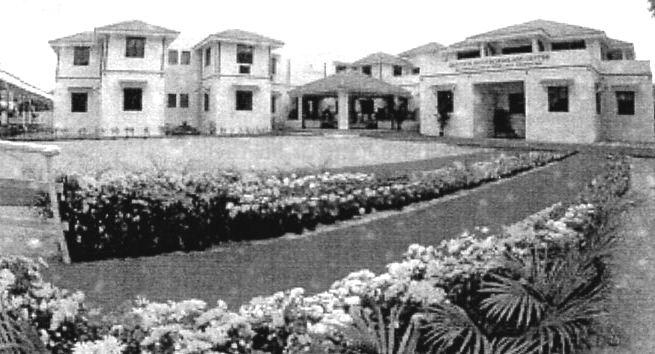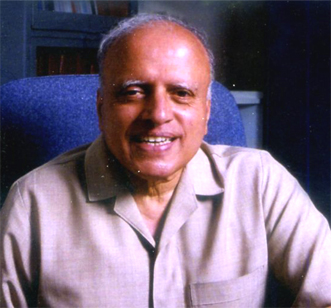
The M.S. Swaminathan Research Foundation headquarters building.

Dr. M.S. Swaminathan
2013 is a landmark year in the life and times of Dr. M.S. Swaminathan. The M.S. Swaminathan Research Foundation, established to promote integrated and sustainable development, completed its 25th year.
Conferred with the Indira Gandhi Award for national integration, Dr. M.S. Swaminathan recalls in an interview the time he and Dr. Vikram Sarabhai went to meet Mrs. Indira Gandhi at her home. “She suddenly asked how soon we could build a foodgrain reserve of 10 million tonnes. I was taken aback, but it became clear to me that India’s dependence on imported food was a major concern of hers.” This triggered the green revolution and production doubled in quick time. “C. Subramaniam, then Food and Agriculture Minister, took the administrative leadership to make this a reality. It is the synergy between science and public policy that reversed the ship-to-mouth situation to implementing the food security bill today,” said Dr. Swaminathan.
The M S Swaminathan Research Foundation was launched in a modest, rented building in Kotturpuram, Chennai. Today, its sprawling campus is tucked away in Taramani, a silent corner in the city. There it focusses on R & D in the areas of mangrove forest restoration, fisheries, medicinal plants, maintaining a gene bank, development of salt and drought tolerant varieties of rice, eco-villages that are self-sustainable, and spreading the knowledge of information technology to the rural masses. The Foundation has adopted the 4C model for sustainable management of agro-biodiversity involving attention to conservation, cultivation, consumption and commerce.
Dr. Swaminathan is today particularly concerned over the poor demographic dividend in agriculture. With the younger generation opting to move to cities, agriculture is in neglect. Fragmented land, lack of scope to implement technology, and a market disconnect in selling the produce deter youth from choosing agriculture as a career. “For young people to take to agriculture, farming must be both intellectually satisfying and economically rewarding. Our agriculture universities should enable every scholar to become an entrepreneur,” stressed India’s leading agro-scientist. A few years ago, the Indian Government had launched a programme to enable farm graduates to set up agri-business centres and agri-clinics. The programme visualised a group of four or five students specialised in various disciplines, such as agriculture, animal husbandry, fisheries, marketing and home science, joining hands and setting up business centres. Agri-clinics could provide the needed advic e for crop health and nutrition during the production phase. Such a multi-disciplinary approach would help in developing the rural economy in a holistic manner. “This did not take off as expected, but if such an approach is followed it would open a new sustainable dimension of agriculture for the youth,” said the agri-scientist.
Dr. Swaminathan pointed to four main challenges that today’s agriculture faces: prime farm land is not being used for agriculture, hard to attract and retain talent for agriculture, changing climatic conditions, and the market connect.
With natural endowments for agriculture shrinking, genetically modified crops are considered the way forward. “I believe that the current concerns of bio-safety and the impact of GM on biodiversity will soon give way to an appreciation of the potential benefits of this new genetics to humankind. Agricultural science and genetics together have fed the world and will continue to feed the world,” said Dr. Swaminathan.
With his vision to get rid of hunger and poverty from the world, Swaminathan was listed in the ‘Time 20’ list of most influential Asians of the 20th Century in 1999. He had earlier received the prestigious World Food Prize (1987), considered equivalent to the Nobel Prize. And he has been awarded the Padma Shri (1967), the Padma Bhushan (1972), the Padma Vibhushan (1989).
Dr. Swaminathan was born and brought up in Kumbakonam where his father, Dr. M.S. Sambasivan, was a prominent public figure (he also served as Municpal Chairman, Kumbakonam). M.S. Swaminathan pursued higher studies at the Tamil Nadu Agriculture College, Coimbatore. But his service years were spent at the Agricultural Research Institute of the ICAR in Pusa, where he worked on genetic modifications of wheat and was closely associated with the green revolution, and in the Agriculture Ministry.
Dr Swaminathan once mentioned the preparation of the blueprint for the green revolution in the early 1960s. With C. Subramaniam taking charge as the Union Minister of Agriculture in the Lal Bahadur Shastri government, the focus on agricultural research, combined with efficient administration and policy back-up, triggered the green revolution.
Dr Swaminathan was actively involved in delineating an agriculture policy and was at the helm of affairs when India turned from a net importer to an exporter of foodgrains. In the 1970s, he functioned as Secretary in-charge of agricultural research and actively promoted intensive research through the dozens of ICAR labs. Later, he shifted to Manila as the Director of the International Rice Research Institute.
It was Chennai’s good fortune that Dr Swaminathan decided to establish his research foundation in the city. With his suave nature, he was close to all government administrations. With his reputation known far and wide, he organised visits of top scientists and administrators in the food and agriculture sectors from across the globe, including the renowned Dr. Norman Borlaug, the father of the Green Revolution in the world. Chennai never had it so good with receiving and hearing a galaxy of international experts involved with food and agriculture.
President Pranab Mukherjee specially came to Chennai to participate in the silver jubilee celebrations of MSSRF. He complimented Dr Swaminathan for initiating the concept of “nutri-farms” to address hidden hunger caused by micronutrient deficiencies and praised his valuable recommendations as Chairman of the National Commission on Farmers for converting the green revolution into an ever-green revolution.
The world owes a great deal to Dr Swaminathan for the focus he has brought on agricultural research and issues of global concerns relating to food and agriculture, gender equality, nutrition, etc. (Courtesy: Industrial Economist)
From begging bowl to bread basket...
For those born after the 1990s it must be amusing to hear that there was once a ship-to-mouth food situation in India. Such was the intensity of the food shortage that large quantities of wheat had to be imported and sent immediately for consumption. Thanks to the continued efforts of the then Union Agriculture Minister, C. Subramaniam, Dr. M. S. Swaminathan and able administrator B. Sivaraman that situation is history today. India was transformed from a begging bowl to a bread basket. For spearheading the introduction of high-yielding wheat and rice varieties to India’s farmers, Dr Swaminathan was awarded the first World Food Prize in 1987. With the award funds, he set up the M.S. Swaminathan Research Foundation in Madras in 1988. The U.N. Environment Programme described him as the ‘Father of Economic Ecology’.
– SV
|

